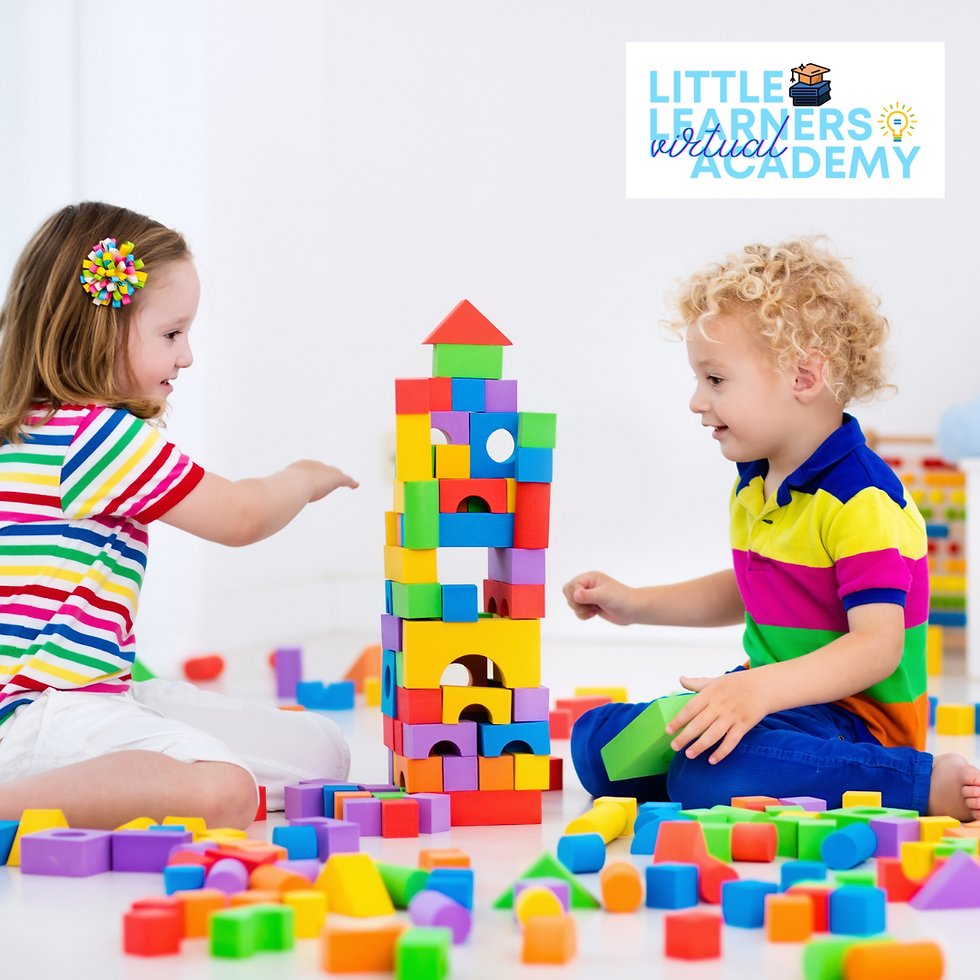Building Blocks & Brain Boost: How Block Play Helps Little Learners Thrive
- mrsblyrocks
- Oct 4, 2024
- 4 min read
Updated: Nov 17, 2024

Playing with building blocks is more than just an entertaining activity—it’s a powerful way to nurture your Little Learner’s cognitive development, creativity, and problem-solving abilities. When your child dives into the world of stacking, balancing, and building, they’re also laying the foundation for skills that will benefit them for a lifetime.
Here’s how playing with building blocks boosts brain power and why it’s worth encouraging in your home:
1. Developing Spatial Awareness
When children handle blocks, they’re learning to understand and navigate the space around them. Stacking blocks, organizing them by size or shape, and creating structures all contribute to their ability to visualize and comprehend spatial relationships.
What is Spatial Awareness? Spatial awareness is the ability to perceive how objects relate to each other in space. For example, understanding that a smaller block fits on top of a larger one without tipping over or recognizing how to balance two blocks of different sizes.
Why is it Important? These early lessons in spatial reasoning help build the groundwork for future skills in math, geometry, and even science. Studies show that strong spatial reasoning can lead to success in STEM fields later in life.
Try This: Challenge your child to replicate a simple structure you build, like a bridge or a tower. This activity helps sharpen their ability to observe, process, and recreate spatial patterns. Try leaving photographs of real buildings—homes, offices, apartments, churches, or schools—near the blocks for inspiration. These serve as real-life models to encourage creativity.
2. Strengthening Problem-Solving Skills
Building blocks naturally present children with challenges that require creative and critical thinking. How can they stop their tower from toppling? How can they make their bridge strong enough to hold more blocks? Each scenario encourages them to experiment, adapt, and learn from their mistakes.
Boosting Creativity and Confidence: As they solve problems, children gain confidence in their ability to tackle challenges. They learn that failure is part of the process and that trying different solutions leads to success.
Try This: Encourage your child to use blocks to solve "real-world" challenges, like building a ramp for a toy car or creating a “house” for a small stuffed animal. These imaginative prompts make problem-solving even more engaging.
3. Encouraging Social Skills Through Collaboration
Block play isn’t just a solo activity—it’s a fantastic way for children to build social skills when playing with siblings or friends. Working together to design a structure encourages teamwork, communication, and patience.
Turn-Taking and Cooperation: Sharing blocks and deciding on a plan for building teaches kids how to take turns, compromise, and work as a team.
Try This: Organize a block-building challenge where your child collaborates with others to create the tallest tower or the most imaginative structure. Celebrate their teamwork, not just the final result!
4. Fostering Fine Motor Skills and Hand-Eye Coordination
Handling small blocks, stacking them carefully, and placing them in precise positions help develop fine motor skills and improve hand-eye coordination. These physical skills are crucial for tasks like writing, drawing, and using scissors.
Try This: Offer a variety of block sizes and textures to keep playtime interesting and challenge their motor skills in new ways.
5. Nurturing Early Math Concepts
Block play introduces early math concepts in a hands-on, intuitive way. Sorting blocks by size or color, counting pieces, and recognizing patterns all contribute to a solid math foundation.
Try This: Ask your child to count how many blocks they used to build their tower or create patterns using blocks of different colors. These small activities make math fun and approachable.
6. Fostering Early Writing Skills
Building blocks can also be a gateway to developing early writing skills. By introducing paper, crayons, or markers alongside block play, you encourage your Little Learner to connect their creations with written expression.
Labeling and Illustration: Encourage your child to label their structures or parts of their building, like writing "Bridge" or "Tower." They can also draw pictures of their creation, adding details and illustrating their imaginative ideas.
Creating Signs and Labeling: Little Learners love to add signs like “Stop!” or “Don’t Touch!” to their block constructions. This helps them see the practical purpose of writing while boosting their creativity and fine motor skills.
Try This: Incorporate paper and crayons with the blocks set up. Prompt your child with questions like, “What’s the name of your building?” or “Can you make a sign for the front door?” These activities combine storytelling and writing, making the experience even richer.
Block Play at Home: Simple and Powerful
The beauty of building blocks is their versatility—they can be as simple or complex as your child’s imagination allows. Whether your Little Learner is constructing a tall tower or designing an entire city, each moment spent playing with blocks is packed with developmental benefits.
Encourage block playtime today and watch as your child’s cognitive skills, creativity, and confidence soar! Try different types of blocks—Legos, soft blocks, wooden blocks. With every stack, they’re building more than a tower—they’re building skills for a brighter future.




Comments